To forage is " to search widely for food or provisions" and a most delicious provision is a glossy jelly. I have miscalculated because this week I opened my last jar of jelly and now I'll have to wait until summer to restock. Until then, I can reflect on jellies past and future. What fruit or berry will I forage this summer/autumn?
Making jelly is like any other skill, you just have to do it enough times to get good at it. But it also helps to understand the science of how a jelly sets. There are a few tricks I have learnt over the years and I continue to learn as I experiment each season. To make a few jars of jelly you need lots of fruit. Buying the ingredients is not economic, so to be a real jelly maker you have to learn to forage.
One of my favourites is crabapple jelly because of it its ruby translucence and it was the first jelly I ever made from foraged crabapples in the Dunedin Botanical Gardens in the 1980's.
There is a lovely crabapple tree in our neighbourhood. Last October I photograph the tree in blossom, promising myself in autumn I would knock on the door and ask if I could harvest the crabapples. Tony, the tree's owner, was happy to give me permission to harvest on condition that I gave him a jar of the finished jelly and left some for the birds. I quickly agreed to the terms as I usually do both anyway.
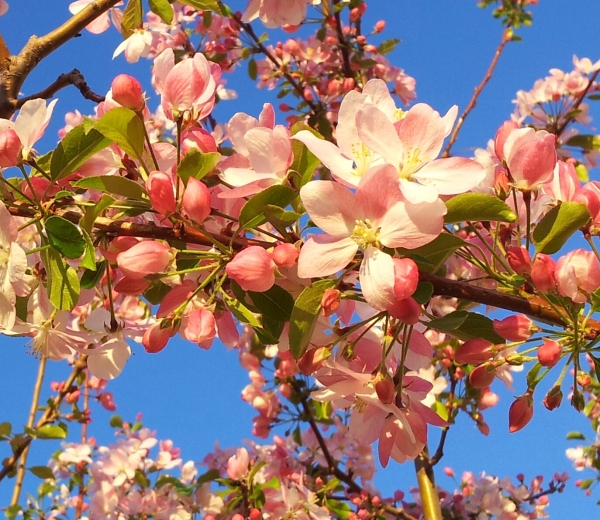
- Crabapple Malus trees are worthwhile to have in your garden for the blossom alone. Some varieties flowers are white.
First step is to wash the fruit a few times to get rid of any dirt or dust.
Add enough water to just cover fruit and no more. At this point you can also decide whether to add some spices or to stay with the natural fruit flavour. I have used cinnamon sticks, bay leaves, kaffir lime leaves, slices of ginger, citrus peel, cardamon, coriander seeds and star anise ...NOT all at once, of course. Choose what best goes with the type of fruit. I tend to use star anise or cardamon with strong flavoured fruit like plums; use ginger, kaffir lime leaves, and coriander to give a tropical touch and add flavour to subtle fruit like guava; cinnamon works well with apple. I would recommend working with the natural fruit flavour first and then think about an extra flavour dimension to the jelly when you make it a second time. If you need to add extra acidity to the brew this is the stage you add either a cut up lemon or lemon juice....more on acidity later.
Simmer until fruit becomes soft and mushy and if still in large pieces use a potato masher to break down further.
Now it's time to strain the fruit pulp through a jelly bag. No need to buy or even sew a special bag - just a length of muslin or cheese cloth will do.
I drape the material into a large bowl (a non-metal container) and gently pour in the pulp, gather up the cloth and slowly raise out of the bowl. The bag has to suspend above the bowl and slowly drip over a day or night. Most important: do not be tempted to squeeze the jelly bag as this will make the jelly cloudy. The easiest way to suspend the bag is in between two chairs with a stick or broom handle. Tie the bag to the stick with string. To avoid small pokey fingers or a curious pet from interfering with the brew, I do this stage overnight. I don't waste the remaining pulp. I tend to put it through a mouli and then use in smoothies or add to porridge.
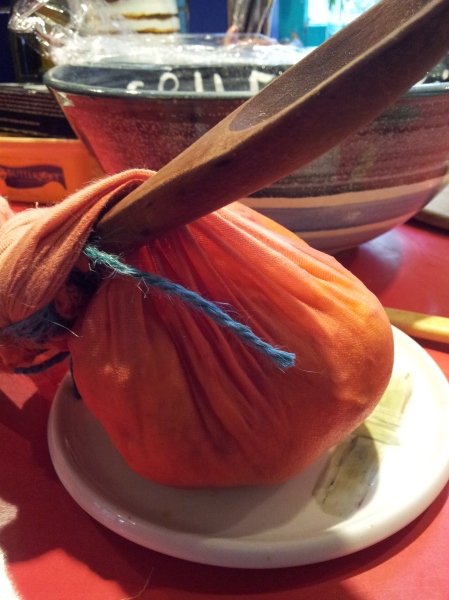
- This jelly was a mix of hawthorn Crataegus and wild roadside apples from Kaweku in Southland and quince Cydonia oblonga from my sister's garden in Dunedin. I only had time to collect a few hawthorn berries so just made a small batch. The added quince was important because the roadside apples weren't that flavourful. The quince would also improve the colour of the jelly.
For a small quantity of fruit you can use a wooden spoon placed over a deep bowl. You may need to keep pouring off the liquid into a jug to ensure the liquid doesn't touch the bag.
Measure the strained juice in cups then heat the strained liquid. For a large quantity of liquid make the jelly in two batches. (I do this because when the sugar is added and starts to bubble, it will greatly increase in volume and the last thing you want or need is overflowing boiling sugar syrup on your stovetop.)
Now I add the sugar. A lot of recipes state cup for cup of sugar and syrup. I find this makes it a little too sweet but it's a fine line - too little sugar and it won't set or keep well. So my standard is 3/4 cup of sugar to every cup of liquid. Sugar is the preserver in the jelly as harmful micro-organisms cannot survive in water that has 60% or more sugar content.
Keep stirring until the sugar dissolves and once it has reached boiling point, stir every few minutes.
Deciding when it has boiled enough is the most tricky part of jelly making. It's actually better to underestimate than to over do the boiling. If it fails to set you can re-boil it ...but you need to add extra sugar as well.
At the beginning of the process I place a couple of saucers in the freezer. If you put a little bit of jelly onto a very cold surface it will cool down quickly and indicate if setting point has been reached.
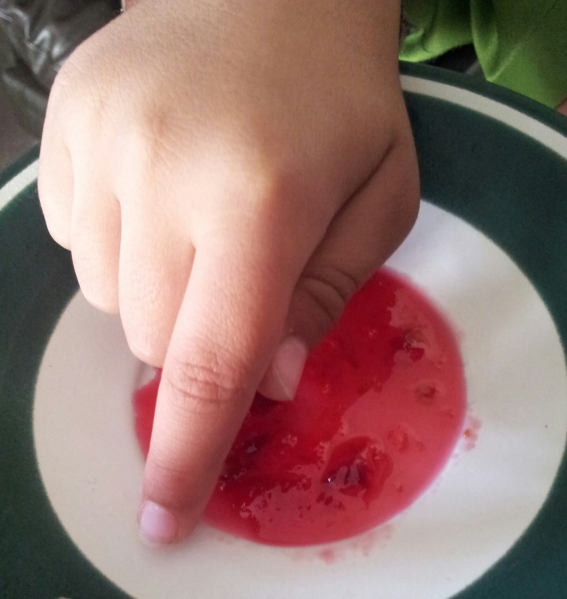
- Here grandson Beau is learning to check setting point by running his finger through the jam or jelly. If a clear track occurs then setting point has been reached.
I also blow across the jelly surface and if it puckers up like a skin forming then it is likely it will set.
Another indicator is the jam spoon that you use to stir the jelly. Is there a sign of setting jelly on the spoon?
It has reached setting point, so I add a knob of butter to assist in dissolving the foam. Some scoop this foam off with a saucer, but I think too much jelly is lost doing that.
The jelly jars have been washed and placed into an oven at around 150 degrees Celsius for at least half an hour to sterilise them. It's important also to have the jars hot when adding the very hot liquid jelly to avoid the jars cracking. I tend to use recycled jars with screw top lids. These lids are sterilised in boiling water for 10 minutes.
Not all jellies turn out perfectly like this crabapple jelly. Sometimes they can be a little too stiff rather like the description of British jam making written by Nigel Slater in "Eating for England",
"The rest of Europe makes jam that slides sexily off the mound of clotted cream and dribbles down the edge of the scone (an exquisite moment if ever there was one). ..We make jam a little bit like ourselves. A jam that is a bit uptight and reserved, a preserve that wobbles tautly rather than falls off the spoon with a slow, passionate sigh."
I have also had the odd jelly that has refused to set. To avoid this happening again I've had to understand the chemistry involved in creating a jelly. Three elements have to work together - pectin, acid and sugar. Sugar separates the water and pectin molecules. Pectin molecules are the gel of the jelly but alone are negatively charged so they won't work together until positively charged acid comes along. Cooking apples, crabapples, currants, gooseberries, japonicas, sour cherries, citrus, and sour plums like Damson are all fruits high in pectin and acidity. Jellies or jams made from these fruits will set quickly and you can use a lower ratio of sugar with these fruits...but because of the tartness of these fruits, you need to make your sugar proportion decision on taste as well.
Quince jelly is loved for its jewel-like quality and is an excellent provider of pectin. But it's low in acidity so to ensure quince jelly sets add extra acid in form of lemon juice or add a couple of sour cooking apples to your quinces when boiling up the cut up fruit.
Apricots, strawberries, raspberries, rhubarb, sweet cherries, pears, medlars and elderberries are lower in pectin and acidity, so these fruits need help. Either you have to marry them with one of the high pectin fruits e.g. gooseberry with rhubarb, redcurrant with strawberry/raspberry, apple with elderberries. Or you can buy jam making sugar that has added pectin and acid. Never use jam making sugar for fruits high in pectin and acid....unless you want the sort of jelly that won't fall out of the jar when upended. These low pectin and low acid fruits on their own need a higher ratio of sugar.
In April I foraged barberries while on a field trip to Chaos Springs on the beautiful Coromandel Peninsula. While admiring the long windrows of organic compost with our organic horticulture class, I spied a hedgerow in the background covered in fruit. I asked Steve, the owner, what were these trees? He replied the hedgerows were established long before he took over the farm and said they were barberries Berberis. I Googled (as you do) and discovered barberries have good nutritional benefits and can be used for making jelly. Steve was happy for me to harvest, warning me that they have vicious thorns.
I was a little uncertain about the amount of pectin in barberries so used the last of the quinces stored in the fridge. Once fruit gets really ripe the amount of pectin reduces, and as both the quince and the barberries were quite ripe, my jelly while tasting delicious didn't really set.
Another sign of a not so perfect jelly showed up four months after it was made. The sugar in the jelly started to crystallise which is a telltale sign that there was not enough acid in the jelly.
I have since learnt from reading Pam Corbin that you can do a quick check to see if your fruit has enough pectin. Cook up some of the fruit and add 1 teaspoon of the cooked fruit juice to 1 Tbsp of whisky, gin or meths. Shake gently and leave for a minute or two. If the juice forms a firm clot it is high in pectin, if it forms several small clots it has medium pectin and if the juice remains fairly liquid then its low pectin.
Making jelly from frozen fruit also reduces the available pectin.
So what jelly am I planning on making next year?
In February I had access to some damsons that I made into damson paste but next year I'm planning on making some damson jelly. The colour and rich flavour should make a stunning jelly and its a fruit that is high in both pectin and acid so the chemistry should be right for a perfect set.


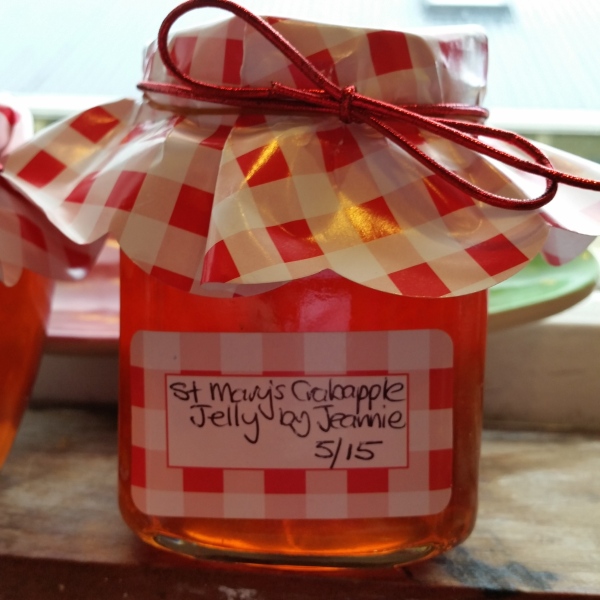
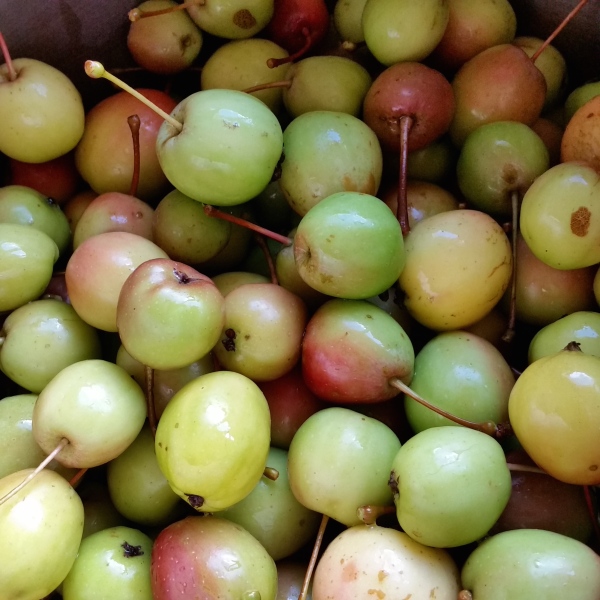
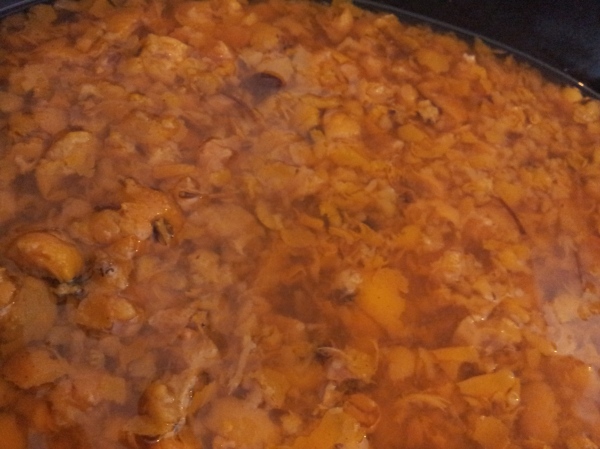

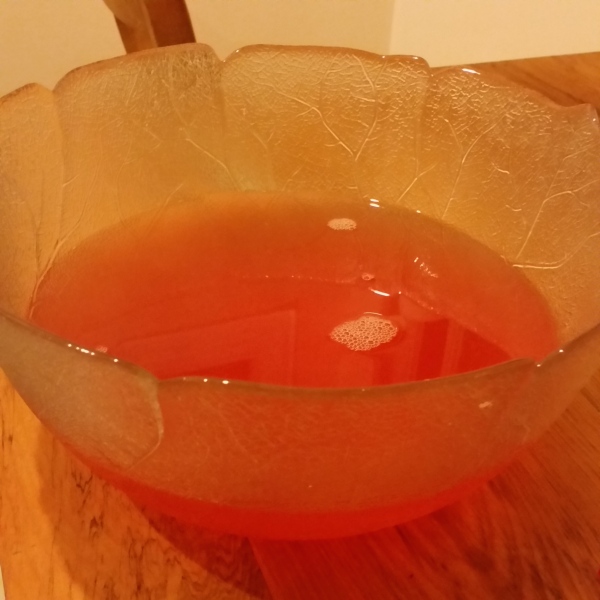

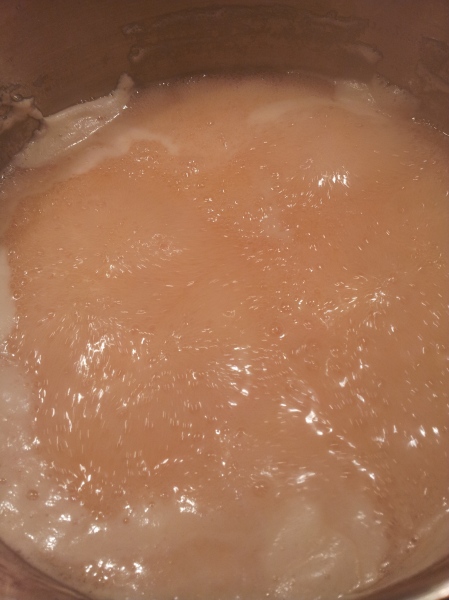
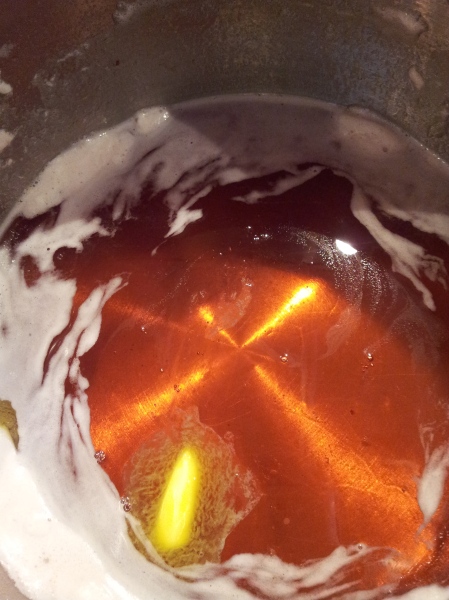

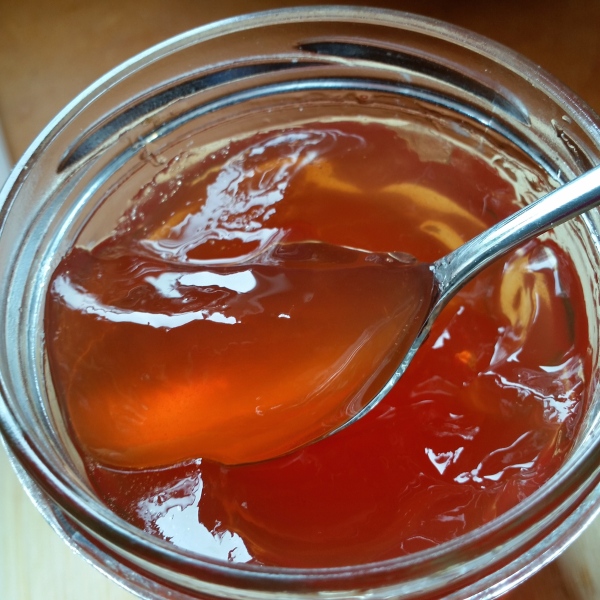
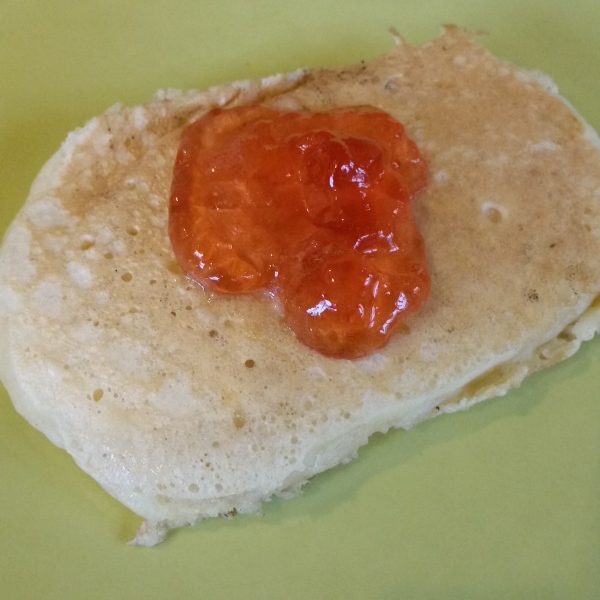
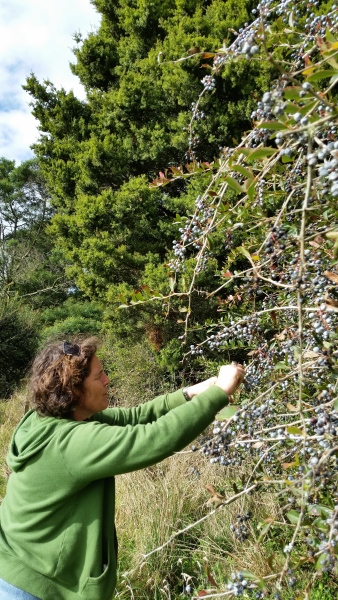

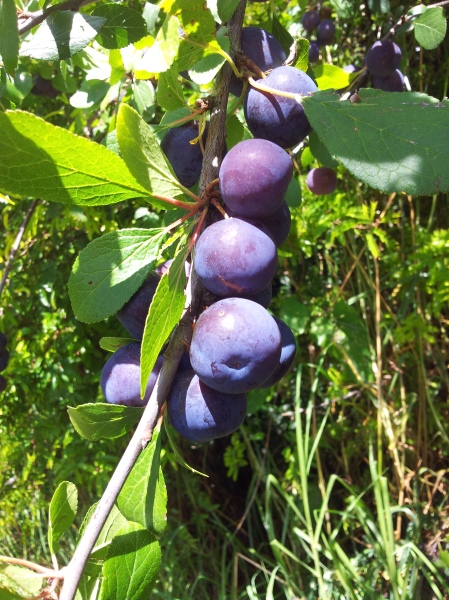
No comments:
Post a Comment
Would like to see your comments or share some of your favourite recipes.